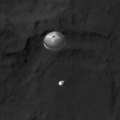English: NASA's Curiosity rover and its parachute were spotted by NASA's Mars Reconnaissance Orbiter as Curiosity descended to the surface on Aug. 5 PDT (Aug. 6 EDT). The High-Resolution Imaging Science Experiment (HiRISE) camera captured this image of Curiosity while the orbiter was listening for transmissions from Curiosity.
Curiosity and its parachute are in the center of the white box; and this image is a smaller cutout stretched to avoid saturation. The rover is landing on the etched plains just north of the sand dunes that fringe "Mt. Sharp".
The parachute appears fully inflated and performing perfectly. Details in the parachute such as the band gap at the edges and the central hole are clearly visible. The cords connecting the parachute to the backshell cannot be seen, although they were seen in the image of Phoenix descending, perhaps due to the difference in lighting angles.
The bright spot on the backshell containing MSL might be a specular reflection off of a shiny area. MSL was released from the backshell sometime after this image was acquired.
This view is one product from an observation made by HiRISE targeted to the expected location of MSL about 1 minute prior to landing. It was captured in HiRISE CCD RED1, near the eastern edge of the swath width (there is a RED0 at the very edge). This means that MSL was a bit further east or downrange than predicted.
The image scale is 33.6 cm/pixel.
Polski: Należący do NASA łazik Curiosity i jego spadochron zostały dostrzeżone przez Mars Reconnaissance Orbiter jak opadały na powierzchnię Marsa 05 sierpnia PDT (6 sierpnia EDT). Teleskop zwierciadlany High-Resolution Imaging Experiment Science (HiRISE) wykonał to zdjęcie, kiedy odbierał transmisję danych z łazika Curiosity.
Łazik Curiosity i jego spadochron znajdują się w centrum białego kwadratu. Z tego zdjęcia wycięto mniejszy fragment i cyfrowo przetworzono. Łazik ląduje na pofałdowanych nizinach na północ od piaszczystych wydm, na skraju "Góry Sharp".
Spadochron jest w pełni wypełniony powietrzem i spełnia się dokonale. Szczegóły spadochronu takie jak szczeliny taśm na brzegach i otwór centralny są wyraźnie widoczne. Linek łączących spadochron z osłoną tylną nie widać, chociaż obserwowano je na zdjęciu z opadającą sondą Phoenix, być może ze względu na różnicę w kątach oświetlenia.
Jasna plama na tylnej osłonie lądownika zawierającego Mars Science Laboratory (MSL), może być lustrzanym odbiciem wziernikowym, poprzez wewnętrzną powierzchnię czaszy spadochronu, od marsjańskiego błyszczącego obszaru. MSL został odłączony od osłony tylnej po zrobieniu tego zdjęcia.
Zdjęcie to jest efektem, z obserwacji poczynionych przez HiRISE, skierowanym do oczekiwanego położenia MSL, około 1 minuty przed lądowaniem.
Fotografowany obiekt został uchwycony w obszarze roboczym kamery HiRISE CCD RED1, w pobliżu wschodniego skraju szerokości roboczej (RED0 jest na samym brzegu). Oznacza to, że MSL był nieco dalej na wschód, lub po przebyciu mniejszego dystansu, niż przewidywano.
Rozdzielczość zdjęcia wynosi 33.6 cm/piksel.




 French
French Deutsch
Deutsch


